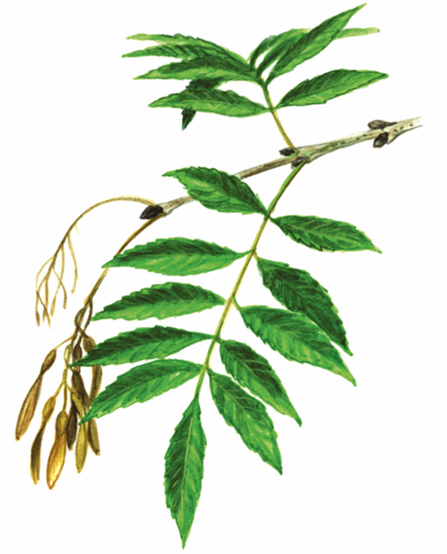In my list of favourite scientific names (do tell me yours), Fraxinus excelsior is a certain feature. For me, the ‘Higher Ash’ (or European ash, as it’s known) sits right up there with the English oak as the most noble of trees. I’m not alone in my reverence. In Norse mythology, Yggdrasill is a giant tree, thought by some to be an ash, which connects the underworld to the earth and the realm of the gods. A symbol of both life and death, the tree is said to be the source of new life after Ragnarök, the end of the world. It was said that Ragnarök will come after moral chaos, extreme winters and the earth sinking into the sea. In a modern world with the threats of climate change being realised and perplexing, ignorant, often morally chaotic politics, perhaps the Ash tree really will be the source of new life…
Ash’s association with the careful balance of life and death, unfortunately, does not end there. Since the 90’s, European ash trees have been succumbing to and dying from infection by Hymenoscyphus fraxineus, a fungus causing disease commonly referred to as ash dieback, or sometimes ‘Chalara’, after its former scientific name. In its native China, it coevolved with ash trees and thus the trees could coexist with the disease, perhaps like we do with the common cold. European ash trees did not coevolve with the fungus, thus when exposed around 30 years ago, they had not developed appropriate defences.
The fungus reproduces in leaf litter on the leaf rachis (the central stalk connecting the individual leaflets), releasing airborne spores than can travel many miles. These spores go on to infect more ash trees and the disease spreads. Once infected, trees begin to die from the top down, with leaves and branches dying back first. Necrosis spreads under the bark to the xylem, in most cases preventing the tree from being able to transport enough water, causing death.
Ash dieback is predicted to kill around 80% of ash trees in Europe. Some areas will see less impact, and some more, but the effects can already be seen across Beds, Cambs and Northants. The Woodland Trust place the cost of ash dieback to British society at £15 Billion, and it is all but certain that the British countryside will look vastly different as a result of the disease. A mainstay of many woods, ash trees have around 955 associated species in the UK. Around a hundred of these species have an obligate association or are highly associated with ash – they rely on ash for food or shelter in some way. The loss of four fifths of our ash trees, as is predicted, will have an inevitable knock on effect, with the potential for the extinction of some of those associated species.
The disease has an impact on how we manage the trees on our nature reserves: the death of branches and limbs makes them brittle and much more likely to snap off, and as roots decay trees become more likely to fall over. These are natural parts of the life cycle of a tree, and ‘standing deadwood’ is fantastic habitat for a wide range of species from woodlice to woodpeckers, treecreepers to tawny owls, and weirder and more wonderful things than even them – but when trees are near paths, roads or other human structures, we need to step in to make sure people are kept safe. This means careful study of trees near paths, and intervention to manage the trees at just the right point – after they have succumbed to ash dieback and the signs are clear the tree is unwell and unlikely to recover, but before the tree poses a significant risk to people. Whilst the focus of this article is ash, we intervene with any tree that shows signs it may pose a risk. All trees at Nene Wetlands and Summer Leys that are near paths, roads or other structures are surveyed annually to check their condition, and works are conducted where needed to mitigate the risk.
Fortunately, it’s not all doom and gloom. There are some silver linings to what is otherwise a pretty rough situation. As mentioned, an increase in standing deadwood in places away from humans is a good thing – historically, as a nation we’ve been far too tidy with our trees, and even on our nature reserves there’s always room for more standing deadwood. So, whilst it’s not good Nene Wetlands is home to some fantastic Ash trees; fortunately the oldest and best for wildlife are away from public areas, so we’ll be able to let them die (or fingers crossed, survive) in peace. Whilst Nene Wetlands is a great place for people to be in nature, this shows the benefit of keeping some areas just for wildlife. We wouldn’t be able to keep them if they were in a public area due to their tendency to shed limbs and the risk of them falling over.
Another silver lining is that the work that we do on the ash trees in public areas will improve the structural diversity of the wooded areas on site, opening up areas for the benefit of more light loving species like butterflies and some wildflowers. In time younger, denser areas of scrub will develop, beneficial to many nesting birds. Structural diversity was discussed previously here.


